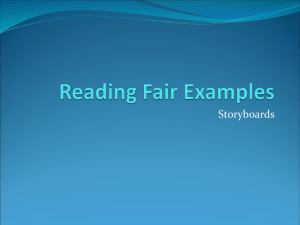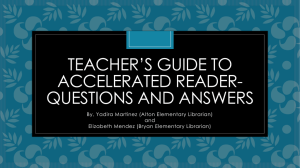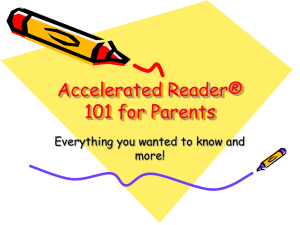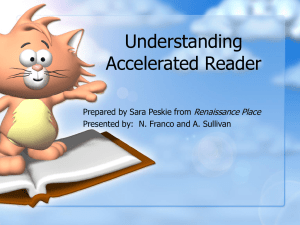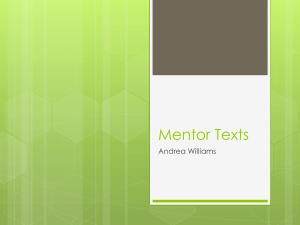power point on star reading & accelerated reader
advertisement
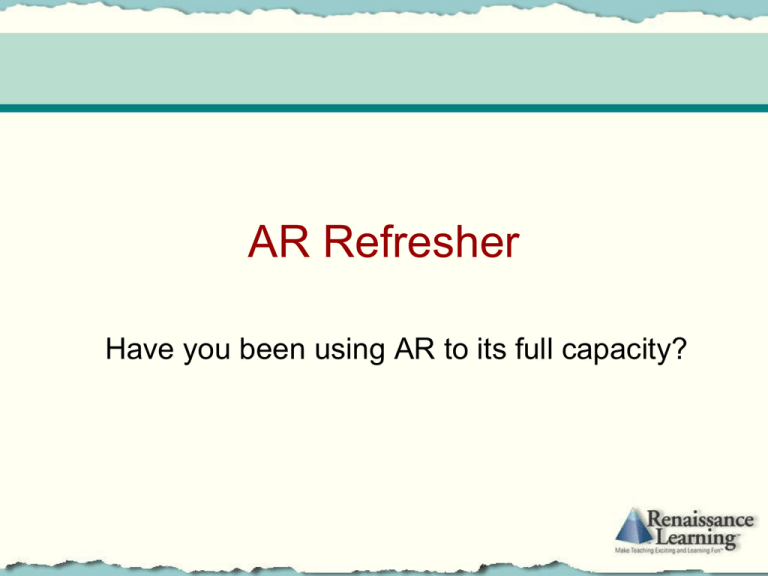
AR Refresher Have you been using AR to its full capacity? Steps to Success • • • • • Individualize Monitor Use data to take action Quality first Make success obvious Accelerated Reader Software: • Renaissance Place (Includes STAR READING Assessment; STAR EARLY LITERACY (new!) Assessment; ACCELERATED READER and VOCABULARY) Allows you to measure and monitor your students’ reading AND VOCABULARY practice STAR Reading • Computer-based assessment of a student’s overall reading ability • Norm- and criterion-referenced • Identifies individual reading ranges • Measures growth STAR Early Literacy • Computer-based assessment for students who are not yet reading independently • Criterion-referenced • Measures growth in 41 early literacy skills • Helps you tailor instruction • Can be administered monthly Best Practices Teaching strategies that maximize the power of Accelerated Reader and lead to reading growth for every student Getting Started • Understand Accelerated Reader, STAR Reading, and STAR Early Literacy • Find the Zone of Proximal Development (ZPD) for each student • Schedule time for daily reading practice: – Read To – Read With – Read Independently Monitoring • Students complete the Student Reading Log daily • Teachers: – Take Status of the Class daily – Check the TOPS Report immediately after each student quiz – Review the Diagnostic Report weekly to determine the level of student and class implementation Intervention and Enrichment • Intervene promptly with struggling readers to ensure successful reading • Set individual student reading goals • Create a system of motivators to encourage students to reach their goals Understanding AR, STAR, and SEL • Accelerated Reader – Student reads a book, takes a quiz on the computer, and reports immediately print to indicate the level of success. Also includes Vocabulary and Literacy Tests. • STAR Reading – Student takes a test on the computer and reports immediately indicate the reading level • STAR Early Literacy – Computer reads a test to the student and reports immediately indicate pre-reading skills—those mastered and those that need to be mastered Find and Use the ZPD • ZPD = Zone of Proximal Development – Book level range appropriate for the student’s reading ability • Use STAR Reading to identify each student’s ZPD • Then examine the following to assist students in book choice for their ZPD: – AR book level (readability) – Interest level (grade appropriateness) – Point value (length and difficulty)/ Word Count (use ARBOOKFIND.COM) Schedule Time for Reading Practice • Daily monitored in-class reading time • Students read their AR books as teacher guides the reading: – Read To – Read With – Read Independently • 20, 30, 60 minutes per day • Goals based on in-class reading time Students Complete Reading Logs • Each independent reader records daily the AR book she is reading: – Level – Points – Fiction/nonfiction – Pages read – Quiz score • Teacher initials daily and writes comments as needed Monitor with Status of the Class Brief, daily, one-on-one conferences with students concerning their reading During Status of the Class: • Review reading log • Check understanding of current book • Detect, diagnose, and solve problems Check TOPS Report Immediately • TOPS Report indicates a student’s results on the quiz and results for the marking period and for the year • First opportunity for intervention and recommendation • Essential for student success • Examine after each quiz to determine student progress Review Diagnostic Report Weekly • Diagnostic Report shows performance of every student in a class • Examine weekly for students at risk and classroom totals • Highlights students that need immediate intervention – See them immediately during Status of the Class Guide Students to Success • Goal: average 85% correct or higher on Reading Practice Quizzes – Demonstrates comprehension of books read – Leads to reading growth – 100% correct is powerful • Intervene if student scores less than 80% on a quiz or averages below 85% Set Goals with Each Student • Setting goals encourages self-directed learning: – Average percent correct (85% or higher) – Points (based on reading level and length of practice) – Book level (based on STAR scores) • Use Goal-Setting Chart as a guideline • Record goals in the computer and on the Student Reading Plan • Accelerated Reader keeps track of students’ progress toward goals Keep Students Motivated • Offer praise and encouragement • Demonstrate your enthusiasm for reading • Help ensure success—it’s the greatest motivator • Celebrate achievement • Celebrate each goal met (i.e.100%; first book read; mixture of author’s/genre’s/ fiction-non fiction, etc) Remember the Steps to Success • • • • • Individualize (goal setting) Monitor (TOPS/Status of the class) Use data to take action (Diagnostic Report) Quality first (average 85% and above) Make success obvious (motivate)
